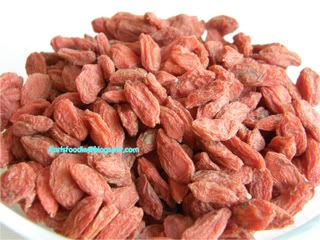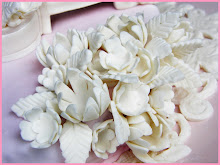Wolf Berry aka 枸杞
Someone ask what is this.. and so I snap a poto of it.. and thought maybe I should do a posting here.
Extracted from Wikipedia
Nutrient content
Macronutrients
Wolfberry contains significant percentages of a day's macronutrient needs – carbohydrates, protein, fat and dietary fiber. 68% of the mass of dried wolfberries exists as carbohydrate, 12% as protein, and 10% each as fiber and fat, giving a total caloric value in a 100 gram serving of 370 (kilo)calories,[27][28] of which 272 come from carbohydrates, and 90 of which come from fat.[29]
Micronutrients and phytochemicals
Wolfberries contain many nutrients and phytochemicalsincluding
11 essential and 22 trace dietary minerals
18 amino acids
6 essential vitamins
8 polysaccharides and 6 monosaccharides
5 unsaturated fatty acids, including the essential fatty acids, linoleic acid and alpha-linolenic acid
beta-sitosterol and other phytosterols
5 carotenoids, including beta-carotene and zeaxanthin , lutein, lycopene and cryptoxanthin, a xanthophyll
numerous phenolic pigments (phenols) associated with antioxidant properties
Select examples given below are for 100 grams of dried berries.
Calcium. Wolfberries contain 112 mg per 100 gram serving, providing about 8-10% of the Dietary Reference Intake (DRI).
Potassium. Wolfberries contain 1,132 mg per 100 grams dried fruit, giving about 24% of the DRI.
Iron. Wolfberries have 9 mg iron per 100 grams (100% DRI).
Zinc. 2 mg per 100 grams dried fruit (18% DRI).
Selenium. 100 grams of dried wolfberries contain 50 micrograms (91% DRI)
Riboflavin (vitamin B2). At 1.3 mg, 100 grams of dried wolfberries provide 100% of DRI.
Vitamin C. Vitamin C content in dried wolfberries has a wide range (from different sources) from 29 mg per 100 grams to as high as 148 mg per 100 grams (respectively, 32% and 163% DRI).
Wolfberries also contain numerous phytochemicals for which there are no established DRI values. Examples:
Beta-carotene: 7 mg per 100 grams dried fruit.
Zeaxanthin. Reported values for zeaxanthin content in dried wolfberries vary considerably, from 25 mg per 100 grams to 200 mg per 100 grams. The higher values would make wolfberry one of the richest edible plant sources known for zeaxanthin content.Up to 77% of total carotenoids present in wolfberry exist as zeaxanthin.
Polysaccharides. Polysaccharides are a major constituent of wolfberries, representing up to 31% of pulp weight
I use this very frequently in cooking rice, porridge, soup, steam fish, and even making of dessert like white fungus dessert as well as my osmanthus cake. It can also be eaten raw.. believe to be good for improving vision.
